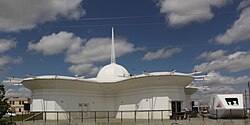Vulcan, Alberta
Vulcan | |
|---|---|
Town | |
| Town of Vulcan | |
 Tourism and Trek Station | |
| Country | |
| Province | |
| Region | Southern Alberta |
| Census division | 5 |
| Municipal district | Vulcan County |
| Government | |
| • Mayor | Thomas Grant |
| • Governing body | Vulcan Town Council |
| • MP | Ted Menzies (Macleod-Cons) |
| • MLA | Pat Stier (Livingstone-Macleod-Wildrose Party) |
| Area (2011)[2] | |
| • Total | 6.58 km2 (2.54 sq mi) |
| Elevation | 1,049 m (3,442 ft) |
| Population (2011)[2] | |
| • Total | 1,836 |
| • Density | 280/km2 (720/sq mi) |
| Time zone | UTC-7 (MST) |
| Postal code span | T0L 2B0 |
| Highways | Highway 23 Highway 534 |
| Railways | Canadian Pacific Railway |
| Website | Official website |
Vulcan is a town in the prairies of southern Alberta, Canada within Vulcan County. It is located on Highway 23, midway between the cities of Calgary and Lethbridge. The population of the town was 1,836 in 2011.[2]
History

The town was named by a surveyor for the Canadian Pacific Railway in 1915 after the Roman God of Fire – Vulcan. Originally all the streets of Vulcan were named after gods and goddesses of the classical world such as Juno, Mars, and Jupiter. In July 1927, a major tornado destroyed many homes and the new curling rink in the town. That tornado was made famous when a photograph of it approaching Vulcan was used for the "tornado" article in Encyclopædia Britannica. At one time,[when?] Vulcan had nine grain elevators, more than any location west of Winnipeg, making it the largest grain shipping point at that time.[citation needed] Due to the changing economics of the agricultural industry, the original elevators were taken down one by one. Today, Vulcan has only one of the "prairie skyscrapers" left that once could be seen miles away. Although not original, this last wooden elevator was built in the 1980s.
A British Commonwealth Air Training Plan air force base, RCAF Station Vulcan, was located a few kilometres southwest of the town during the Second World War. Many of the old hangars still exist and the runways can still be seen.
Geography
Climate
Vulcan experiences a dry continental climate (Köppen climate classification Dfb) with long, cold winters and short, warm summers.
| ||||||||||||||||||||||||||||||||||||||||||||||||||||||||||||||||||||||||||||||||||||||||||||||||||||||||||||||||||||||||||||||
Demographics
In the 2011 Census, the Town of Vulcan had a population of 1,836 living in 768 of its 865 total dwellings, a −5.4% change from its 2006 population of 1,940. With a land area of 6.58 km2 (2.54 sq mi), it had a population density of 279.0/km2 (722.7/sq mi) in 2011.[2]
In 2006, Vulcan had a population of 1,940 living in 814 dwellings, a 10.1% increase from 2001. The town has a land area of 6.58 km2 (2.54 sq mi) and a population density of 294.8/km2 (764/sq mi).[5]
Economy

The town's economy is mainly tourism and agriculture-based. Wheat, canola and barley are the main crops grown in the Vulcan area.
Tourism
The town's name has brought some attention that has helped it become a tourist attraction.[7][8] In the Star Trek television and feature film series it is the name of the homeworld of Spock and his fellow Vulcans.
Capitalizing on this coincidence, the town has built a Star Trek–themed tourist station (the Tourism and Trek Station), which provides tourist information, displays Star Trek memorabilia, provides unique photo opportunities, and allows visitors to participate in The Vulcan Space Adventure virtual reality game. Nearby, a replica of the starship Enterprise from Star Trek V has been mounted on a pedestal which includes writing from Trek alien languages like Klingon. The town has also created space-themed murals and signs, and hosts an annual community-wide Star Trek convention known as "Spock Days". This convention attracts hundreds of Star Trek fans from around the world.[7] In 2013, the TrekCetera Star Trek museum opened in Vulcan. [9]
Since 1990, Vulcan has hosted the annual Vulcan Tinman Triathlon, which takes place at the beginning of June. This sprint-distance triathlon attracts nearly 1,000 participants.[citation needed] There are classes for adults of all ages and skill levels as well as for teams and children.
See also
References
- ^ "Municipal Officials Search". Alberta Municipal Affairs. 9 May 2019. Retrieved 1 October 2021.
- ^ a b c d "Population and dwelling counts, for Canada, provinces and territories, and census subdivisions (municipalities), 2011 and 2006 censuses (Alberta)". Statistics Canada. 8 February 2012. Retrieved 8 February 2012.
- ^ "Alberta Private Sewage Systems 2009 Standard of Practice Handbook: Appendix A.3 Alberta Design Data (A.3.A. Alberta Climate Design Data by Town)" (PDF) (PDF). Safety Codes Council. January 2012. pp. 212–215 (PDF pages 226–229). Retrieved 9 October 2013.
- ^ Environment Canada—Canadian Climate Normals 1971–2000, accessed 23 March 2010
- ^ Statistics Canada (Census 2006). "Vulcan – Community Profile". Retrieved 2007-06-13.
{{cite web}}: Check date values in:|year=(help) - ^ http://www.vulcantourism.com/about-vulcan-albertas-star-ship-fx6-1995-a.html
- ^ a b Pawlowski, A. (22 August 2013). "Live long and prosper in Vulcan, the 'Star Trek Capital of Canada'". NBC News. Retrieved 22 August 2013.
- ^ Cernetig, Miro (8 September 1990). "Small Town Ties Spacey Idea: Vulcan turns to 'Star Trek' to boost image". Toronto Globe and Mail.
- ^ "Vulcan's TrekCetera Museum opens today". Retrieved 9 February 2014.

